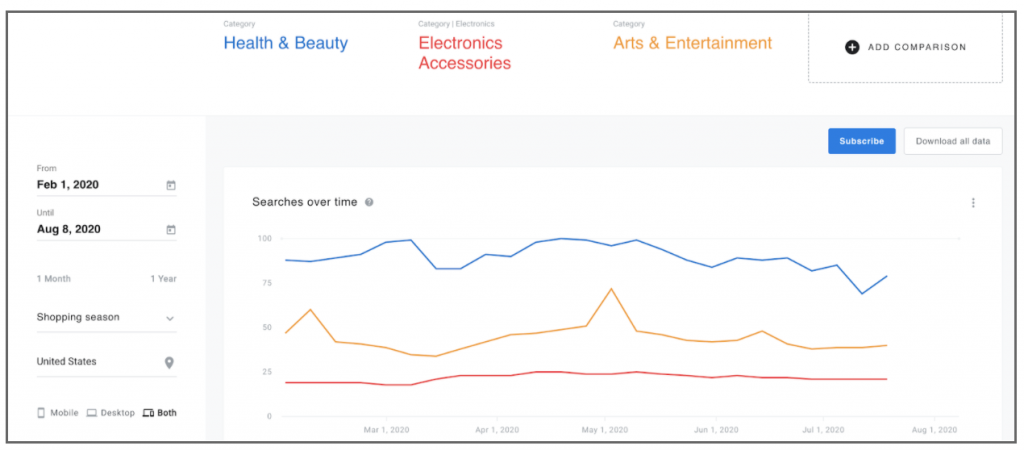This holiday season will be a special one. Some big box stores have already announced they won’t be opening for Black Friday, and consumer behavior will significantly change with social distancing recommendations. What actions can online retailers take to have a successful holiday season this year if it’s totally online? This article discusses some of the challenges that online retailers will face this year, and an action plan to get their digital analytics and marketing strategies ready for this omni-channel season.
Winning Micro-Moments
It’s not new that micro-moments are transforming by the way consumers shop. According to Ipsos and Google U.S. Omnichannel Holiday study for 2019, even when customers want to shop in-store, they research online before making a decision. This past holiday season, shoppers searched online before 89% of in-store purchases. Furthermore, 78% of shoppers used more than three channels to shop within a two-day period, making an omnichannel strategy more important than ever.
This year, however, retailers will need to win micro-moments to win shoppers for the holiday season as everyone is starting to behave as an omni-channel shopper. The key to win micro-moments is being able to know customers’ actions across channels and show them what they expect or need at each moment –and you’ll have the ability to answer before they ask! Retailers need to focus their efforts on delivering personalized, relevant experiences that shoppers have come to expect in their micro-moments.
Challenge
Showing up in all micro-moments, anticipating the customer need to create a seamless experience across channels.
Action Plan
Be discoverable at these moments, coordinating your paid search efforts with personalized experiences to build your brand awareness and connect with your customers at each moment.
Tracking web visitors who come to the store is key to understanding what worked and what didn’t for those customers in your omni-channel plan, and how new features such as BOPIS affected your traffic. This is available in Google Analytics Store Visits reports when you activate Google Signals. You will see the number of visits to your business’s physical locations from users who visit your website, across different channels and marketing campaigns. This is crucial when making informed decisions about your ad creatives, spend, bid strategies, and other elements of your campaigns that aim to find customers in specific moments such as geo-targeting.
Enable cross-device reports to have cohesive insights into how seemingly unrelated touchpoints, sessions, and interactions are connected. Retailers specifically are ahead of other businesses in this area, as most retailers have a unique identifier for their customers with customer profiles or loyalty programs, and can seamlessly get a well-rounded view of their customers as they jump from one device to another. Google Analytics can provide these reports once you enable User-ID views and track user ID across devices.
Acquiring and Retaining Customers
Many of the customers who usually came to the store to window shop during the holiday season are now online leaving their digital footprints everywhere on the website. This is an opportunity for retailers to acquire these new customers and grow the customer base. Retailers have a better chance to get to know these potential customers and understand their behavior when they are online. Behavioral data about users are significantly better than demographics and psychographics when it comes to predicting things like purchases, upgrades, and churn. Analyzing what these new customers do on the website, will provide insights on their next action.
Challenge
Acquiring the new website visitors and being able to reach them at future moments.
Action Plan
Engage the new customers to turn discovery into purchase intents; using personalization experience for new website visitors (example: using Google Optimize) or on-site surveys.
Build audiences of the new visitors for retargeting and activation in other marketing and optimization platforms. Building audiences based on user behavior sets a good foundation for a marketing strategy to re-engage shoppers and convert that brand discovery into purchases and conversions. Tagging your website with the necessary audience setup is crucial and must be done ahead of the holiday season to capture the window shoppers during their discovery visits.
Reframe & Plan Ahead
An important retailer’s lesson from the crisis and store closures back in March is to constantly reassess, reframe, and plan ahead. Some of those learnings will surely be incorporated into the long-term business strategy.
In this unique time where consumer behavior is changing rapidly and unpredictably, what the marketing team decided two weeks ago isn’t necessarily appropriate today. The one constant assumption we have in this situation is that things will change. Thus, for retailers to maximize opportunity, they need to continually reassess every possible touchpoint for their brand. Marketers will continue asking themselves: campaigns that started last week or even yesterday, are they still right for the context and moment?
Challenge
Keeping up with changing customer behavior and shopping trends.
Action Plan
Enhance on-site analytics to analyze customer behavior and be able to identify the quality sessions and what factors affect customer behavior. Setting up Smart Goals and reviewing Session Quality metrics is a great start to identify the highly engaged users and create user segments and audiences based on those metrics as well as identify personas and specific paths to conversion.
Keep up with shopping trends by using Google tools that are available to all retailers to research what customers are looking for in different retail categories, by brand and keyword.
- Google Shopping Insights provides insights into customer research, shopping, and purchase behaviors. For example, a big-box retailer looking for what’s being purchased right now to have on the homepage special offers or email campaigns; the report below shows a comparison of different categories of products and trends on customers’ interest and purchases in each category.
- Rising Retail categories tool allows retailers to keep up with the continuously and unpredictable changing consumer behavior. It’s an interactive tool to understand fast-rising retail categories in Google Search in different areas around the world.
- Google Trends can show you interest in certain topics by reporting on how frequently a given search term is entered into Google’s search engine.
Google Shopping Insights

It’s the Most Wonderful Time of the Year
I can almost hear the holiday music while writing this, but I know that this holiday season we won’t be in the shopping malls to hear it, so let’s make sure we have the websites and micro-moments ready with holiday music as we’re counting down to Thanksgiving! Also, if you’re getting a headstart on preparing your reports and dashboards for the holidays, read this blogpost for some templates and shortcuts for holiday reports.


